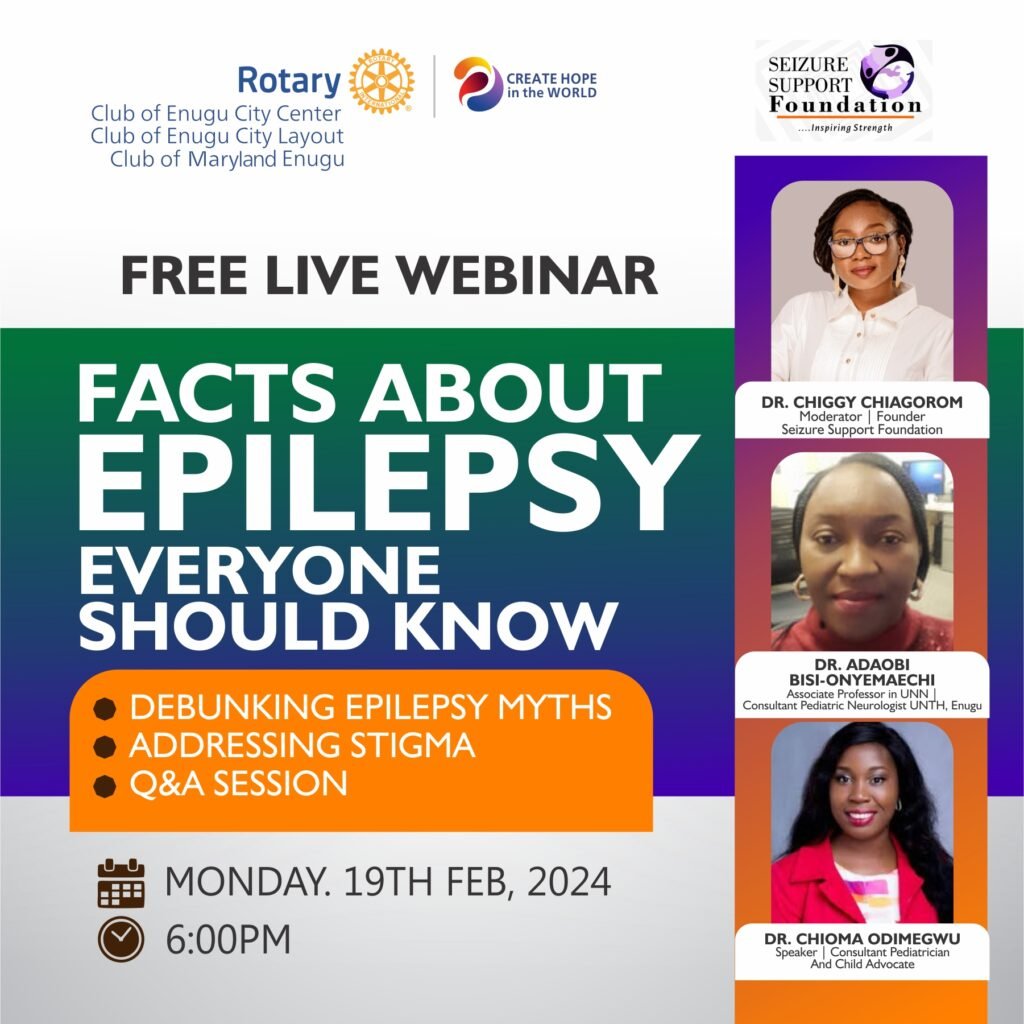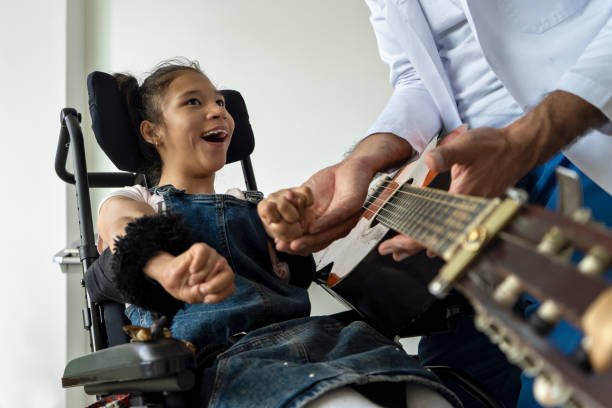JOIN US FOR OUR FREE WEBINAR “Self – care Strategies For Busy Women: Prioritizing Mental Wellness in Hectic Environments”

Did you know stress and mental disorders can cause physical illness? Ever encountered someone who seems physically sick even when medical tests show they’re okay? Interested in learning coping strategies for parenting a child with special needs? Seizure Support Foundation in partnership with Rotary Clubs of Enugu City Center, Enugu City Layout, Maryland Enugu presents *”Self Care Strategies for Busy Women: Prioritizing Mental Wellness in Hectic Environment.”* Time: Mar 22, 2024 05:00 PM West Central Africa Explore the link between stress and brain functions Learn signs of stress, and find the best strategies to manage it. Gain coping strategies for parents raising children with special needs. Don’t miss this chance to learn how to lead a happier, healthier life! Join Zoom Meetinghttps://us06web.zoom.us/j/89210367777?pwd=p0xQZSQiFzcZeL2GsjXoc2rbmhMMa0.1 Meeting ID: 892 1036 7777Passcode: 837833 — One tap mobile+16694449171,,89210367777#,,,,*837833# US+16699006833,,89210367777#,,,,*837833# US (San Jose) — Dial by your location• +1 669 444 9171 US• +1 669 900 6833 US (San Jose)• +1 719 359 4580 US• +1 253 205 0468 US• +1 253 215 8782 US (Tacoma)• +1 346 248 7799 US (Houston)• +1 646 931 3860 US• +1 689 278 1000 US• +1 929 205 6099 US (New York)• +1 301 715 8592 US (Washington DC)• +1 305 224 1968 US• +1 309 205 3325 US• +1 312 626 6799 US (Chicago)• +1 360 209 5623 US• +1 386 347 5053 US• +1 507 473 4847 US• +1 564 217 2000 US Meeting ID: 892 1036 7777Passcode: 837833 Find your local number: https://us06web.zoom.us/u/klIsIy34J #SelfCare #MentalWellness #Webina
JOIN US FOR OUR FREE WEBINAR: Facts about EPILEPSY Everyone Should Know

Join Us for Our Free Live Webinar Series! https://us06web.zoom.us/j/88609952221?pwd=kIa1LbFOtm9JDE11K814P9TwOD3x0V.1 Are you have questions about epilepsy but feel too intimidated to ask? Do you want to know more about managing epilepsy and supporting your loved ones but don’t know how or where to start? Then Seizure Support Foundation’s inaugural webinar, “Facts about Epilepsy Everyone Should Know,” is just for you! https://us06web.zoom.us/j/88609952221?pwd=kIa1LbFOtm9JDE11K814P9TwOD3x0V.1 In this engaging and informative webinar, we’ll debunk myths, address stigma, and provide answers to any questions you may have. Our expert speakers will cover everything from understanding epilepsy triggers to practical tips for supporting someone with epilepsy in your life. By attending this webinar, you’ll not only gain valuable knowledge but also join a supportive community of individuals who are on a similar journey. Plus, we’ll be hosting a live Q&A session where you can get your burning questions answered by our knowledgeable speakers. https://us06web.zoom.us/j/88609952221?pwd=kIa1LbFOtm9JDE11K814P9TwOD3x0V.1 Don’t miss out on this opportunity to empower yourself with knowledge and connect with others who share your experiences. Mark you calendars now, save the date and take the first step towards understanding epilepsy and supporting those affected by it. follow link to join meeting. Details on the flier! https://us06web.zoom.us/j/88609952221?pwd=kIa1LbFOtm9JDE11K814P9TwOD3x0V.1
The Transformative Power of Music Therapy for Children with Neurodevelopmental Challenges

Music therapy emerges as a powerful tool, offering profound benefits in the realm of education, particularly when teaching children with neurodevelopmental challenges. Among these challenges, autism stands out, where conventional methods often fall short. Music, with its inherent non-verbal medium, becomes a bridge, enabling these children to communicate and connect with others in ways that traditional approaches might not. One of the key advantages of music therapy lies in its ability to foster social interaction. Group music activities provide a structured and supportive environment where children can develop and practice social skills. For children with neurodevelopmental challenges, socializing can be a daunting task, but music breaks down barriers, creating a shared experience that transcends verbal communication. Beyond the social realm, engaging in rhythmic activities and musical games contributes significantly to cognitive development. Attention span and concentration are honed through the rhythmic nature of musical engagement. For children facing neurodevelopmental challenges, this enhancement in cognitive abilities is not just advantageous but can be transformative, opening doors to improved learning experiences. The development of fine and gross motor skills is another area where music therapy shines. Whether it’s playing musical instruments or engaging in rhythmic movements, these activities promote the refinement of motor skills in a manner that is not only effective but also enjoyable. For children with neurodevelopmental challenges, this approach offers a more engaging alternative to traditional therapies. Moreover, music therapy has the capacity to stimulate various areas of the brain. This multi-faceted impact can potentially support cognitive functions such as memory, problem-solving, and spatial-temporal skills. The rhythmic and melodic elements of music engage the brain in ways that transcend the auditory experience, creating a holistic cognitive workout that proves invaluable for children grappling with neurodevelopmental challenges. An often underestimated aspect of music therapy is its potential to address speech and language goals. Tailored music therapy sessions can be designed to specifically target communication skills. Through the rhythmic patterns and melodic expressions inherent in music, children can develop and enhance their speech and language capabilities. For educators and therapists working with neurodevelopmental challenges, incorporating music therapy becomes a versatile tool in their arsenal. The impact of music therapy extends beyond the child to involve parents in the therapeutic process. Music therapy sessions that incorporate parents create unique opportunities for bonding and shared experiences. This integration of family into the therapy setting not only strengthens familial relationships but also provides a continuum of support that extends beyond the therapy sessions. Incorporating music therapy into teaching strategies for children with neurodevelopmental challenges can provide a holistic and engaging approach. Traditional teaching methods may struggle to address the diverse needs of these children, but music therapy, with its multifaceted benefits, offers a more comprehensive solution. The rhythmic and melodic elements of music become not just tools for communication and cognitive development but also pathways to unlocking the latent potential within each child. In conclusion, music therapy stands as a beacon of hope in the realm of education for children with neurodevelopmental challenges. Its unique ability to facilitate non-verbal communication, foster social interaction, enhance cognitive development, and refine motor skills makes it an indispensable tool for educators, therapists, and parents alike. As we delve deeper into understanding the complexities of neurodevelopmental challenges, music therapy emerges as not just a complementary approach but a transformative force, unlocking doors to a brighter and more inclusive future for these children.
The Transformative Power of DVM for Neurodevelopmental Challenges in Children

In the realm of special education and intervention for children with neurodevelopmental challenges, the utilization of innovative teaching techniques is pivotal. One such groundbreaking approach is Discrete Video Modeling (DVM), a method that intricately breaks down concepts into digestible segments. This article explores the effectiveness of DVM in forming new neural pathways in children with neurodevelopmental challenges, following research findings showing improvements in IQ levels of children with different types of neurodevelopmental challenges after five – weeks intervention using DVM. This article also delves into its strengths, and examines limitations, particularly concerning communication barriers and the need for culturally authentic content. Discrete Video Modeling: An Insight into the Methodology Discrete Video Modeling, a dynamic and adaptive teaching strategy, emerges as a beacon of hope for children with neurodevelopmental challenges. At its core, DVM dissects complex concepts into individual, easily understandable components. This approach employs repetition and harnesses the power of visual and auditory pairing, offering a multisensory learning experience. Effectiveness of DVM: Enhanced Comprehension: DVM’s segmentation of information aids in enhanced comprehension for children with neurodevelopmental challenges. Bite-sized, repetitive content allows for better retention and understanding, facilitating the formation of new neural connections. Multisensory Learning: The combination of visual and auditory elements in DVM caters to diverse learning styles. Multisensory experiences contribute to heightened engagement, making the learning process more effective Repetition as Reinforcement: Repetition is a cornerstone of DVM, reinforcing key concepts and promoting memory retention. This repetitive nature contributes to the establishment of robust neural pathways. Limitations of Discrete Video Modeling: Navigating Barriers While DVM stands as a transformative tool, it is essential to acknowledge its limitations, particularly when considering communication barriers and cultural nuances. Cultural Authenticity: Cultural Sensitivity: DVM content may not always align with the cultural background of the learners. Cultural disparities may lead to a lack of resonance, hindering the effectiveness of the modeling approach. Communication Barriers: Language Challenges: Commercially available DVM online learning tools employ video models who speak American English, using accents and intonation that is unfamiliar to local learning population. This poses as a communication barrier for the students. Addressing Limitations: Indigenous Video Content Development Cultural Inclusivity: Indigenous video content should be designed with cultural sensitivity, acknowledging and respecting diverse cultural perspectives. Inclusivity fosters a sense of belonging and ensures that neurodevelopmental interventions are culturally relevant. Community Collaboration: Collaborating with local communities is crucial in the development of indigenous video content. Engaging community members ensures authenticity, as local nuances and cultural intricacies are accurately represented. Language Adaptation: Adapting content to local languages addresses language-related barriers. Multilingual approaches accommodate diverse linguistic backgrounds, fostering a more inclusive learning environment. Customization for Learning Styles: Recognizing diverse learning styles within a community is essential for effective content development. Conclusion: Paving the Way Forward Discrete Video Modeling emerges as a powerful tool in the realm of neurodevelopmental interventions for children. Its effectiveness in forming new neural pathways is evident, particularly when tailored to individual needs. However, addressing communication barriers and cultural nuances is essential for maximizing its impact. The development of indigenous video content holds immense promise in mitigating these challenges. By incorporating local nuances, respecting cultural authenticity, and adapting to diverse learning styles, we can create a more inclusive and effective educational landscape. It is through these nuanced approaches that we pave the way forward, ensuring that neurodevelopmental interventions are not only evidence-based but also culturally resonant and accessible to all.
